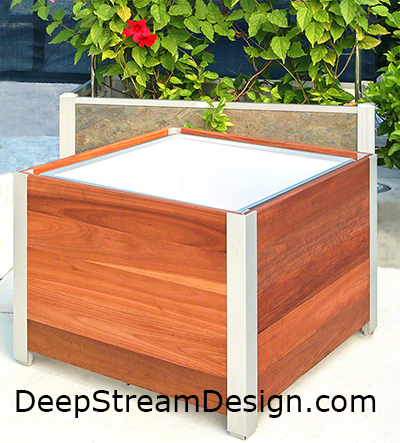Planter Drainage starts with Planter Liners
Water in, water out. Simple, right? However more plants die from lack of planter drainage than under watering and it’s an expensive, time-consuming, waste of time to deal with poorly draining planters that ultimately have to be dug up and remedied.
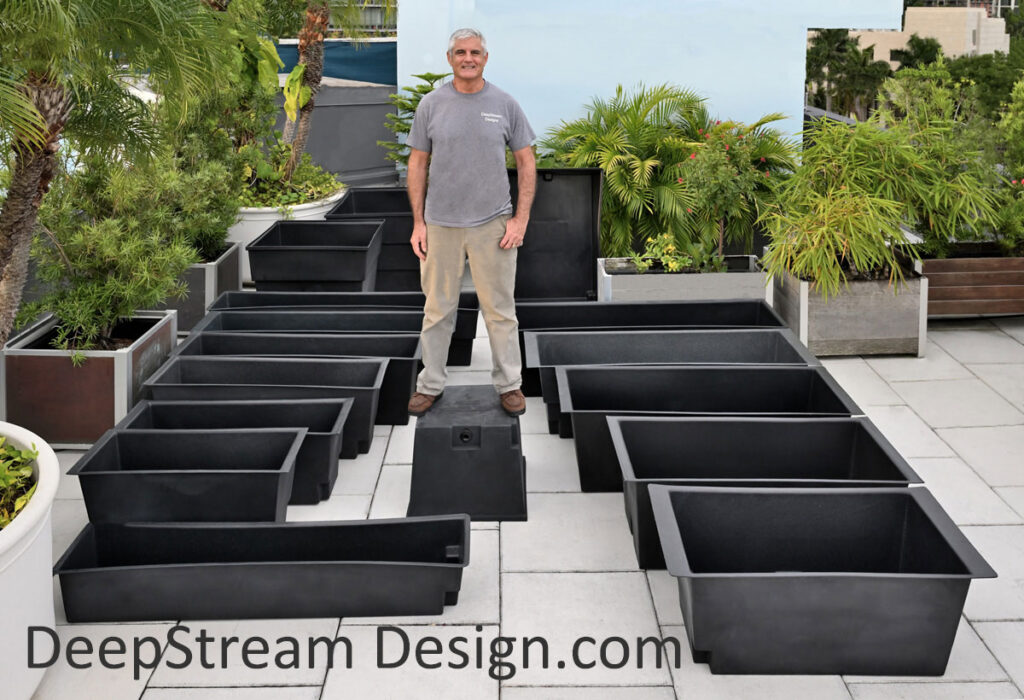
Planter drainage is often the weakest link in the delicate balance of nature required to maintain planters and container gardens. This article on planter drainage will present the simple physics, costs, and benefits of advanced drainage system alternatives you should know before installing plants in planters.
If your interested in where drainage falls into the larger overall consideration of planter design and construction click here for details on Planter Selection. The solution ultimately comes down to the design of the waterproof planter liner, or container, design, drain placement, and blockage.
For those of you who have not had the benefit of walking the trade show floor at a Landscape Architect conference, or who did so without this aspect in mind, I will introduce a “high-tech alternatives” that I am incorporating as options into planters I design for DeepStream Designs. Click: for printed instructions on drainage.
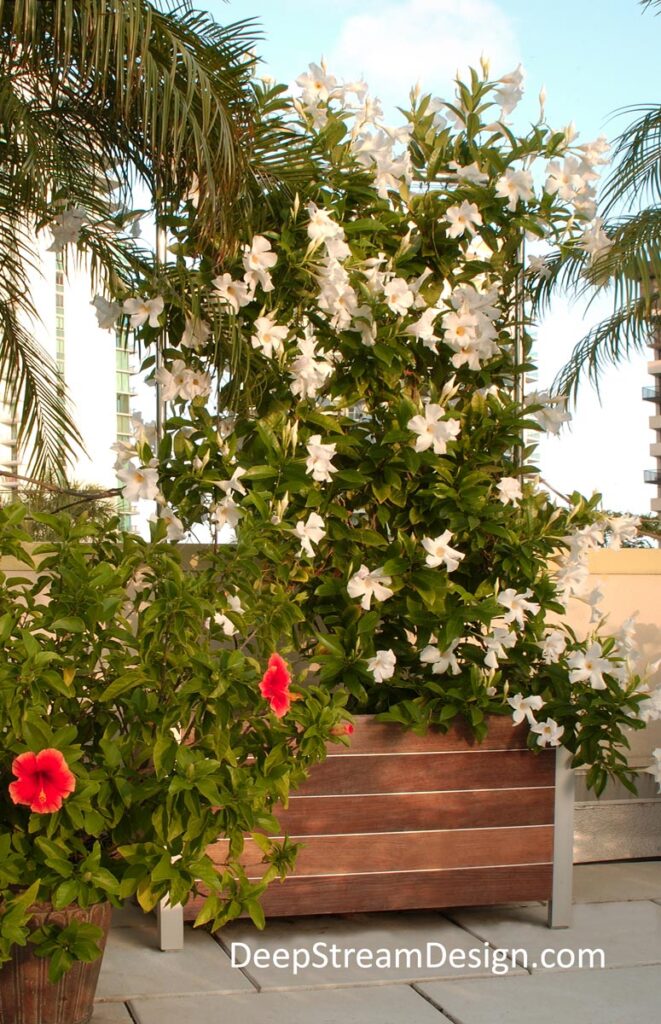
The Drainage Problem
As a Developer and Property Manager I had to deal with planter drainage problems in large built-in concrete planters, and properties with lots of medium-sized stand-alone planters. I can tell you that it is an expensive, time-consuming, and demoralizing task to deal with poorly draining planters that ultimately have to be dug up and remedied.
As prevalent a role as solar gain-induced thermal shock to root systems plays in stunting or killing container-grown plants, the lack of efficient planter drainage is a far more common reason for failure, at least in rainy climates. Water-soaked roots from a lack of proper planter drainage can kill a plant in less than 24 hours, whereas baking and steaming roots in a single-wall planter or pot can take weeks, or even months, before the plant finally succumbs.
Here in Florida, storms can dump 6″ of rain in just a few hours, so it is easy to overwhelm a poor planter drainage system, and you can literally see containers overflow the top. However, long periods of drizzle and gray sky, conditions found on the west coast, combine low evaporation with soaking soil which also subtly builds up fatal water levels in containers without an effective drainage system.
Drain size and blockage
The primary reason for water build up is a malfunctioning watering system, combined with a drain clogged by dirt or roots, NOT too small a drain.
Given that a planter filled with nothing but water 6″ deep will drain at the rate of about a cubic foot per minute through a 3/4″ opening, no amount of rain alone will overwhelm a properly functioning planter drain. Single-point drains of this size are convenient to use for inconspicuous controlled planter drainage systems on balconies, rooftops, and courtyard patios. The key to making this work over the long-term is technology and design.

Issues with built in planters drainage
If you have read the Blog article on Planter Selection and Design, or looked in-depth at the DeepStream Designs’ website planter section, you may remember that the reason I ended up designing free-standing planters was to avoid the structural problems associated with built-in planters: waterproofed planters built into buildings with poured concrete will at some point succumb to settlement cracks, as well as drainage issues. Even the best sprayed, rolled, or troweled-on concrete liner systems I have seen will leak at some point in time, and digging in them doesn’t help.
So if you have plans for specimen plants, or are planting trees that will grow too large for workers to lift by hand, make sure you have crane access to lift the trees, or some way to get forklifts or other types of equipment like tripods in to lift the plants out of the planter for repairs, or to bring in new ones should major plants die.
Avoid building or buying planters or liners with drains in the bottom where you will have to remove large plants to get at them. Install a vertical 2″ PVC pipe up to the final soil level, with a removable top to keep soil out, before filling the planter with soil so that you can pump water out in an emergency before the plants drown.
Solutions
Proper planter drainage is the element that the container industry is least likely to talk about, because it is relatively complex and is not readily “packaged” for sale. Making potential customers of larger pots and containers aware of drainage issues is seen as a negative sell, so it is brushed off with instructions to “Drill a couple of more holes in your pots.” This is an area in which DeepStream can bring great added-value to its customers.
With that said, the advice to drill more holes falls into the “Just because they said it doesn’t make it not true” department. It is, in fact, the most cost-effective approach for smaller, easily re-potted plantings that you can lift out, in pots which slope evenly outward as the pot wall moves towards the top. This simple classic form facilitates the removal of the plant to clean out blocked drainage holes without damaging either the pot or the plant. Essentially, you are pre-planning for blockage by increasing the size of drains that will be clogged.
Free standing planter drainage
When considering free-standing planters, and larger planter liners hidden behind a decorative facade, keep them small enough to work on. Break the planted area up using multiple overlapped liners, rather than one big liner with one point of failure and lots of plants to remove to find the problem, or to die in the event of a catastrophe.

It is not just the cost of the plants to consider, but also the considerable disruption and effort to find and remedy the problem. There is also the mess to clean up, especially on rooftops in urban areas, and the potential for cosmetic damage to the building by workers during the process.
Soil Mixture
Soil mixture is a critical consideration, both for the plant and the building weight limits, as we often find on rooftop and balcony projects. You are looking for soils that will hold nutrients, PH, and moisture within fairly specific ranges that best suit what is being planted, while at the lowest possible weight. Very seldom is “dirt” just dumped into a container.
This soil selection process, done right, eliminates much of the problem caused by “fines”, the small clay-like particles that block filter membranes. Use perlite to increase drainage rates in wet climates or it’s opposite, vermiculite, to retain water in dry climates, under balconies or indoors.
Another drainage consideration is filtration and root blockage. A planter is really just a shaped French drain. Small particles of clay (fines) are carried by the gravity-induced water flow downward towards the drain. Unfiltered, these fines will block any filter membrane in a remarkably short time. The standard way to create a rough filter well area is to fill the bottom of a planter or pot with a few inches of gravel over a bottom drain.
One key design factor of DeepStream planters is that they uses a liner within a decorative facade. This not only prevents solar gain, but also hides drip irrigation lines and the drain. This is important in aiding filtration because the drain does not need to be limited to the bottom of a pot as it will quickly clog.
Drain Location
When considering drainage for large planters, and which planter forms to purchase, the first step is drain location: Realize: YOU WILL HAVE TO DIG UP OR REPOT YOUR PLANTERS SOMETIME!
Yes, that’s the dirty secret. It is inevitable. The question is: how long can you go between major events. Even though drainage issues can often be fixed with the plants in place if the planter liner is properly designed with a taper form wider at the top, as DeepStream’s are, it is much more convenient to avoid them, and less costly over the long run as well.
DeepStream’s liners locate the standard 3/4″ drain a couple of inches up the sidewall creating a “well” below the drain. Fines tend to settle down into this “well”, as water flowing towards the sidewall drain tends to be very slow under most circumstances, so most fines gradually work their way to the bottom. The well also acts as a small water reservoir for the larger roots.
Advanced drainage solution
DeepStream’s advanced drainage system includes a 4″ by 6″ drain board (think of a thin, uncrushable egg crate covered with geo-textile covering) to increase the drainage surface area. The drain board comes hot-glued over the drain. When adding the plants to the planter, be sure not to compress this drainboard against the side of the planter wall with a force or a hard root ball, or it will act as a perfect seal against the drain and stop all water flow. Additionally, there is a roughly 2 sq ft piece of weed block fabric to be folded over and placed over the drain board as further protection against penetration by roots.
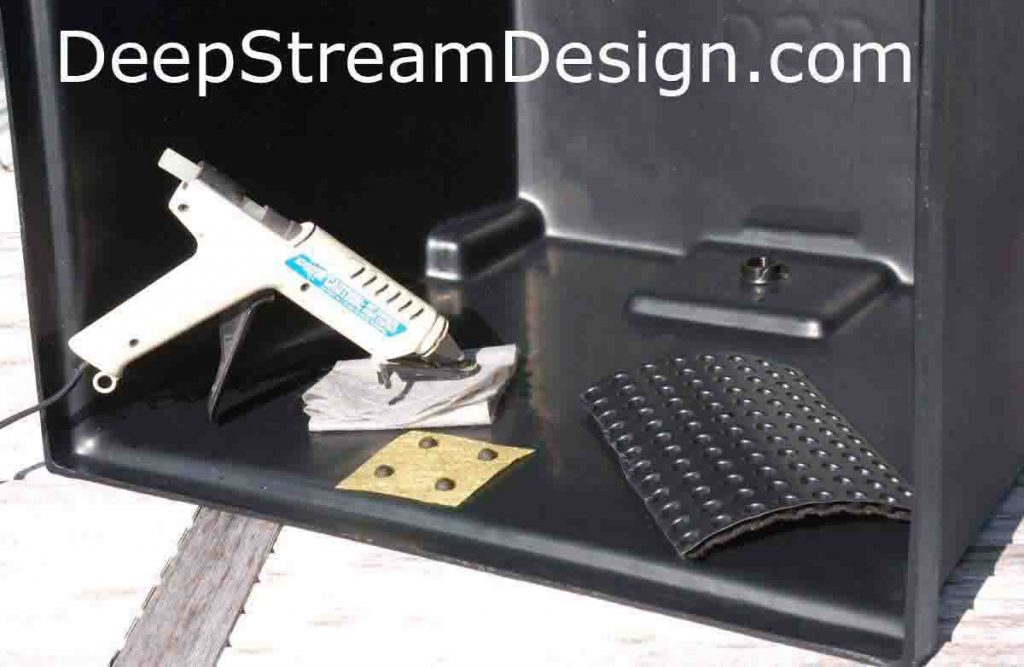

Weed Block, as geo-textile is often marketed, is a misnomer. The “30-year commercial landscaper” variety you see at the large home centers will have roots growing through it in less than 2 years. That said, it still helps delay the inevitable, and DeepStream still provides it with the standard drainage kit.
It is highly recommended that the geo-textile fabric is kept in place by the very important filter of at least a 2″ thick covering of very clean, very coarse sand of between 1 and 2 mm particle size. For reference, the wire of a medium paper clip is 1 mm. While very coarse sand is hard to find, it is the best filter, although it does nothing to block root penetration. Masonry or playground sand is too fine and will compact and prevent drainage; pea gravel lets too many fines through, and they will block the filter fabric.
One good and available material, though not perfect, is Paver Base and Pearlite found at Home Depot. Most of the grains in Paver Base are large enough, but it still has a lot of fines in it but it keeps the Perlite in place well when potting. The well in DeepStream’s commercial grade planters is plenty deep to handle this without clogging the drain.
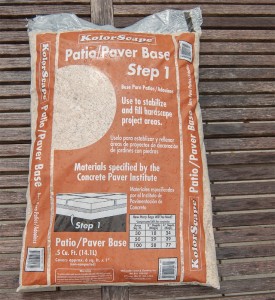
Technology Enhanced Filtration: Two Steps
The most important aspect of new drainage technology is in preventing root blockage. DeepStream now offers an optional root control fabric, BioBarrier (TM) with a plastic-embedded non-systemic herbicide, with a lower toxicity than table salt or aspirin, that creates a 2″ thick root deflection zone around the drainage material by preventing root cell tip division. The product, guaranteed effective for 15 years, has been used as a weed control system for more than 35 years in agriculture to prevent weed growth between row crops. Now, with proper filtration, one should be able to go 15 years without digging up a planter, usually a job performed every 2-3 years in heavy rainfall areas.
Giant sports stadiums and golf courses, with millions of dollars at stake if drainage fail use high-tech crush-proof mats of plastic tubing covered with geo-textile to ensure a large drainage area and directed water flow to prevent damage to grass and delays in play caused by flooding.
DeepStream now offers this same advantage in its single-point directed flow system uniquely adapted for balconies, roof gardens, interior courtyards and other areas where drainage control is required. This is lighter, more effective, and allows for deeper planter medium than less effective gravel systems.
